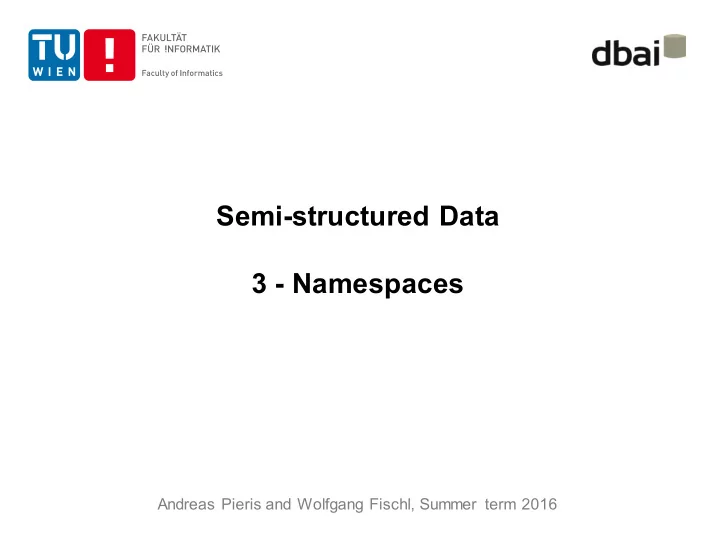

Semi-structured Data 3 - Namespaces Andreas Pieris and Wolfgang Fischl, Summer term 2016
Outline • The Need for Namespaces • Namespace Syntax • Default Namespace • Multiple Namespaces
A Common Problem • Merging of XML documents often leads to conflicts <!-- Students’ Evaluation --> <!-- University’s Evaluation --> <course> <course> <title> SSD </title> <title> SSD </title> <assessment> Fair </assessment > <assessment> Elective </assessment > </course> </course> • The two assessment elements are semantically different • How we distinguish these two elements?
Solution 1 - Renaming • Simply rename the assessment elements <studassessment> Fair </studassessment > <univassessment> Elective </univassessment > • … but there are some weaknesses: o The new element names are not transparent o We may get new conflicts in the future
Solution 2 - Refined Renaming • Rename the elements, but use a separator <stud:assessment> Fair </stud:assessment > <univ:assessment> Elective </univ:assessment > • … but still: o Although the new element names are transparent o We may get new conflicts in the future
Solution 3 - Unique Names • We can exploit URIs (Uniform Resource Identifier) o http://www.oeh.ac.at - Austrian Students’ Union o http://www.tuwien.ac.at - TU Wien <http://www.oeh.ac.at:assessment> Fair </http://www.oeh.ac.at:assessment > <http://www.tuwien.ac.at:assessment> Elective </http://www.tuwien.ac.at:assessment > • Transparent and unique element names • But, the new document is not well-formed - not valid XML names
Final Solution - Namespaces • Combination of solutions 2 and 3 - Namespaces • Mechanism to associate the prefixes stud and univ with the URIs <!-- Students’ and University’s Evaluation --> <course xmlns:stud =“http://www.oeh.ac.at” xmlns:univ = “http://www.tuwien.ac.at” > <title> SSD </title> <stud:assessment> Fair </stud:assessment > <univ:assessment> Elective </univ:assessment > </course> ATTENTION: Namespace URIs are simply identifiers, they are not followed as links
The Need for Namespaces Namespaces have two purposes in XML: • Disambiguating elements and attributes Distinguish between elements and attributes from different vocabularies that share the same name but are semantically different • Grouping elements Group related elements and attributes together so that programs can easily recognize them
Namespace Syntax • A namespace declaration is of the form: xmlns:prefix=“name” where prefix is an XML name, and name is a URI • It appears as an attribute in an element <course xmlns:stud=“http://www.oeh.ac.at” xmlns:univ= “http://www.tuwien.ac.at” >
Namespace Syntax • For elements and attributes qualified names are used of the form prefix:local-name where both prefix and local-name are XML names <stud:assessment> Fair </stud:assessment > <univ:assessment> Elective </univ:assessment >
Default Namespace • We can have a default namespace declared as xmlns=“name” • We simply remove the prefix <!-- Students’ and University’s Evaluation --> <course xmlns =“http://www.oeh.ac.at” xmlns:univ = “http://www.tuwien.ac.at” > <title> SSD </title> <assessment> Fair </assessment > <univ:assessment> Elective </univ:assessment > </course> ATTENTION: Default namespace applies only to unprefixed elements, not attributes
Multiple Namespaces • We can redefine a prefix or the default namespace <!-- Students’ and University’s Evaluation --> <course xmlns = “http://www.tuwien.ac.at” > multiple definitions of <title> SSD </title> the default namespace <assessment xmlns =“http://www.oeh.ac.at” > Fair </assessment > <assessment> Elective </assessment > </course>
Multiple Namespaces <!-- Students’ and University’s Evaluation --> Expanded Names <course xmlns = “http://www.tuwien.ac.at” > {http://www.oeh.ac.at}assessment <title> SSD </title> <assessment xmlns =“http://www.oeh.ac.at” > Fair {http://www.tuwien.ac.at}assessment </assessment > <assessment> Elective </assessment > </course> • The closest ancestor with a namespace declaration takes precedence • If there is no declaration among the ancestors: o For the default namespace the empty namespace is used o For a prefix we get an error (when the prefix us used)
Recommend
More recommend